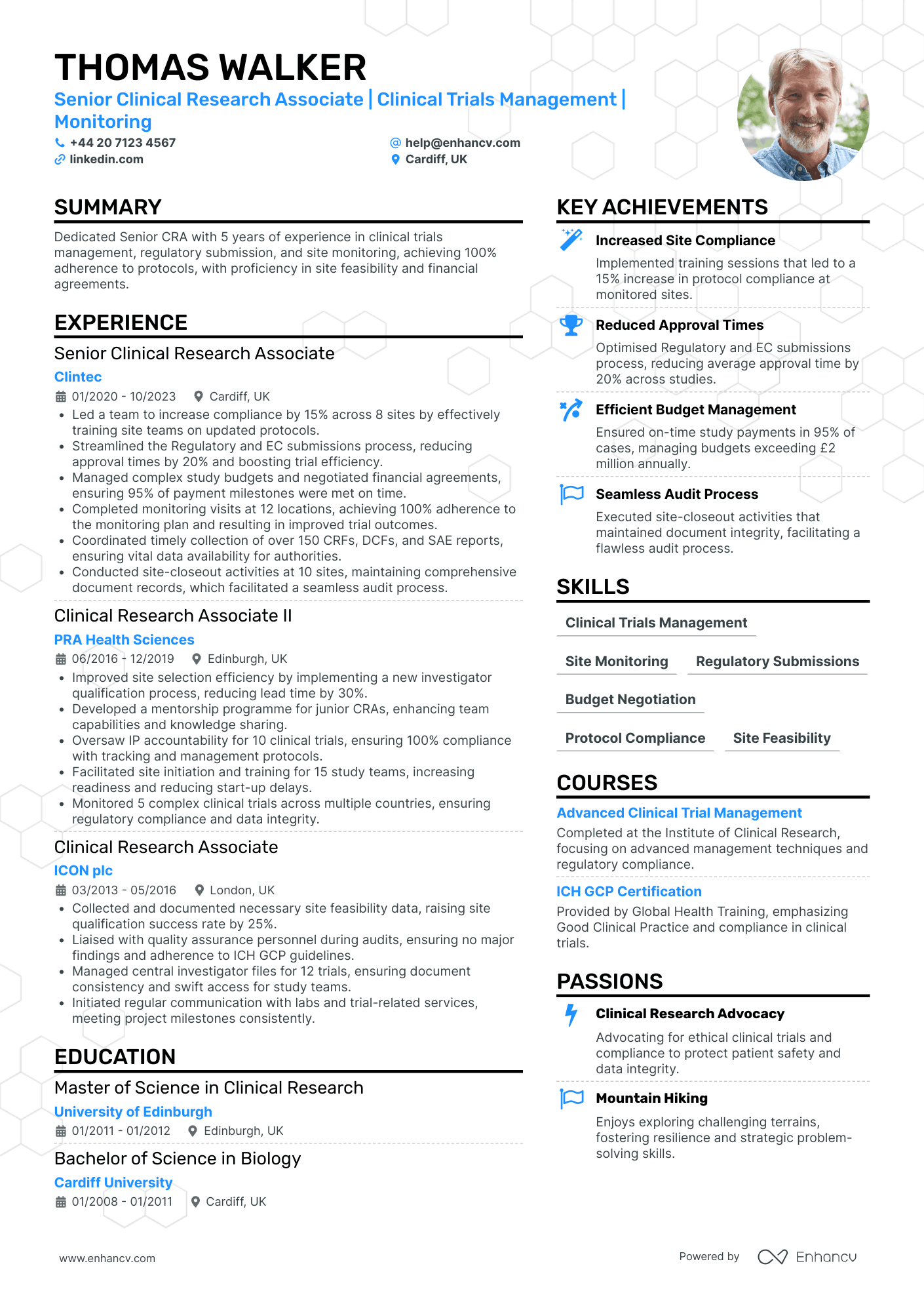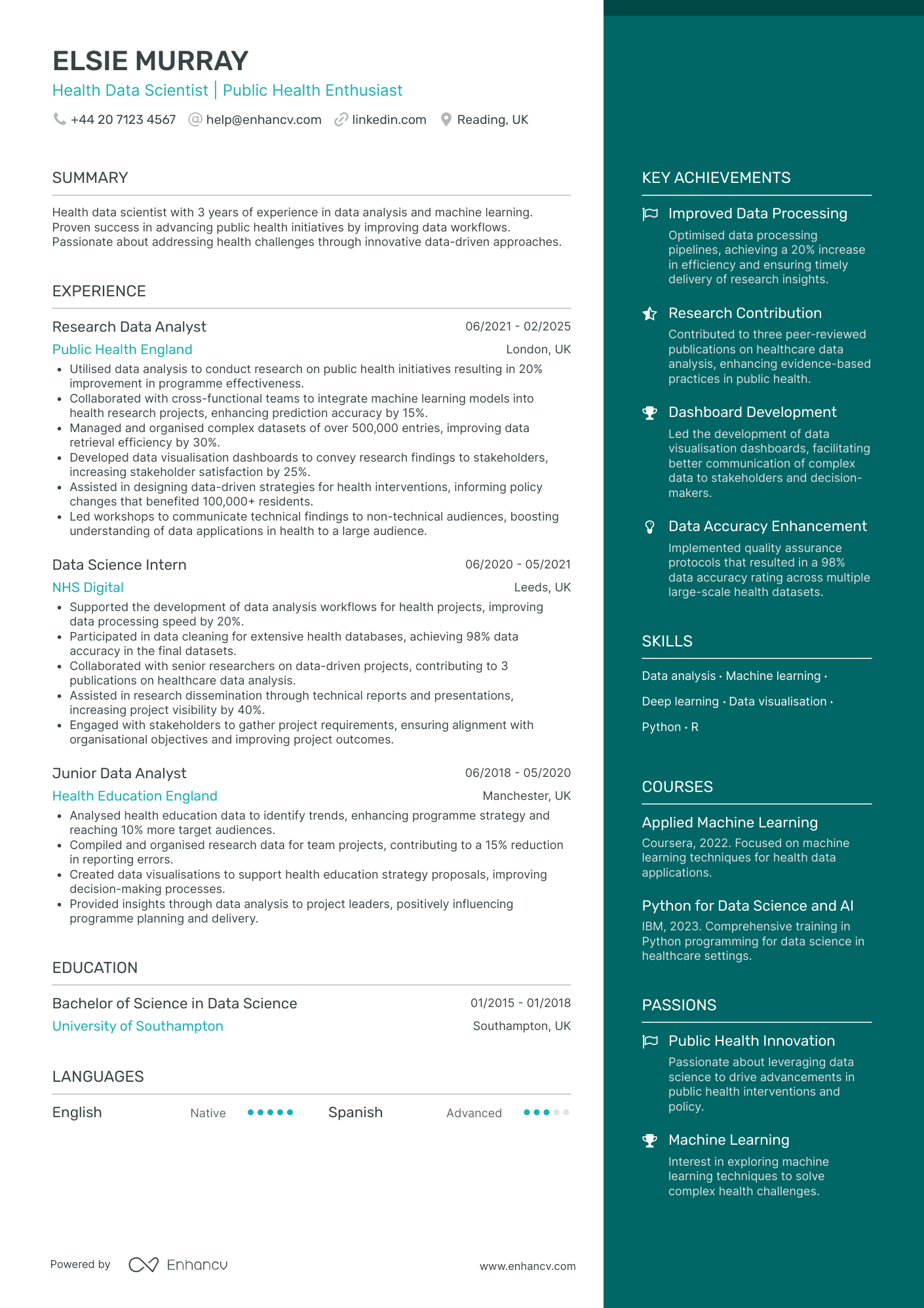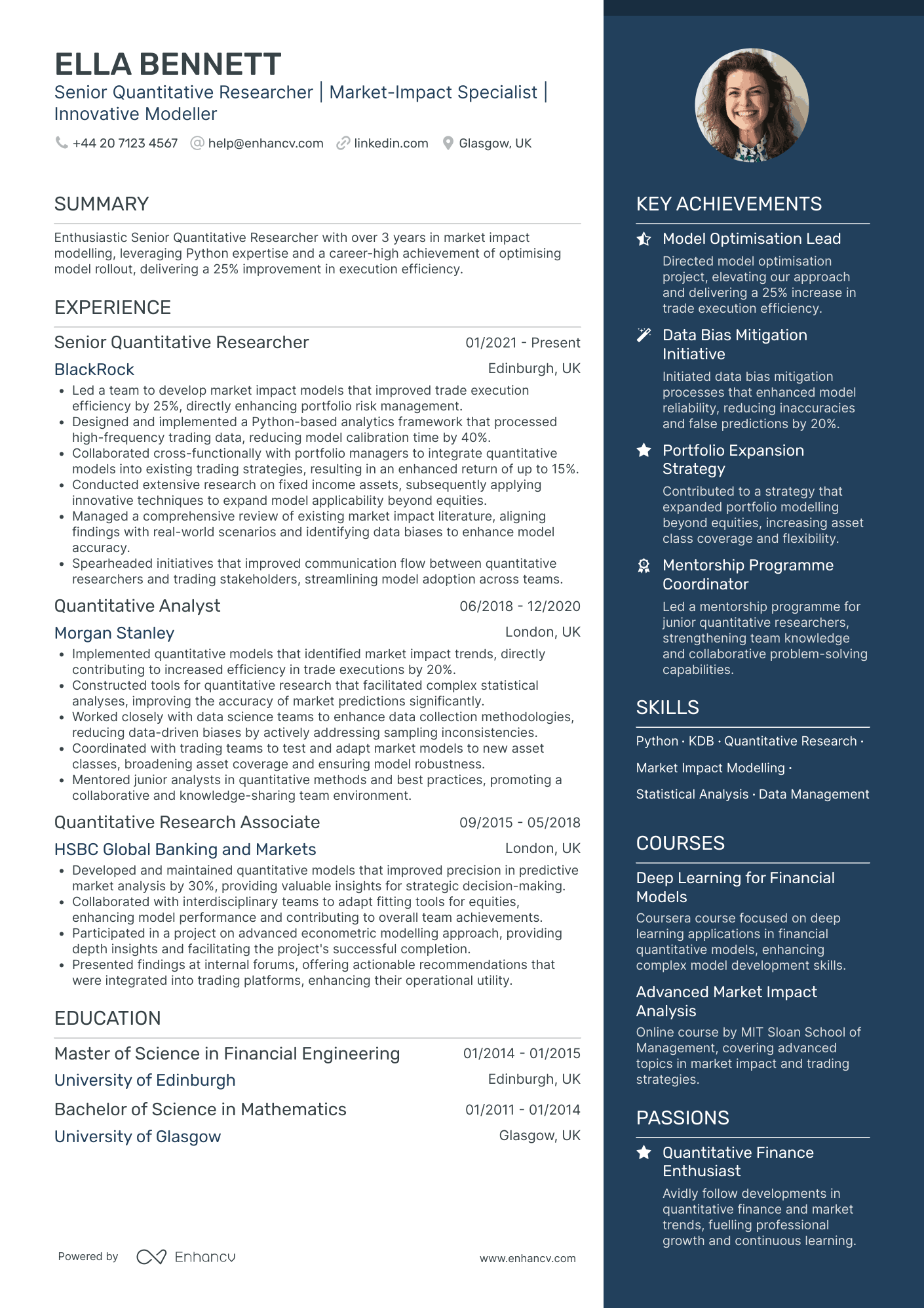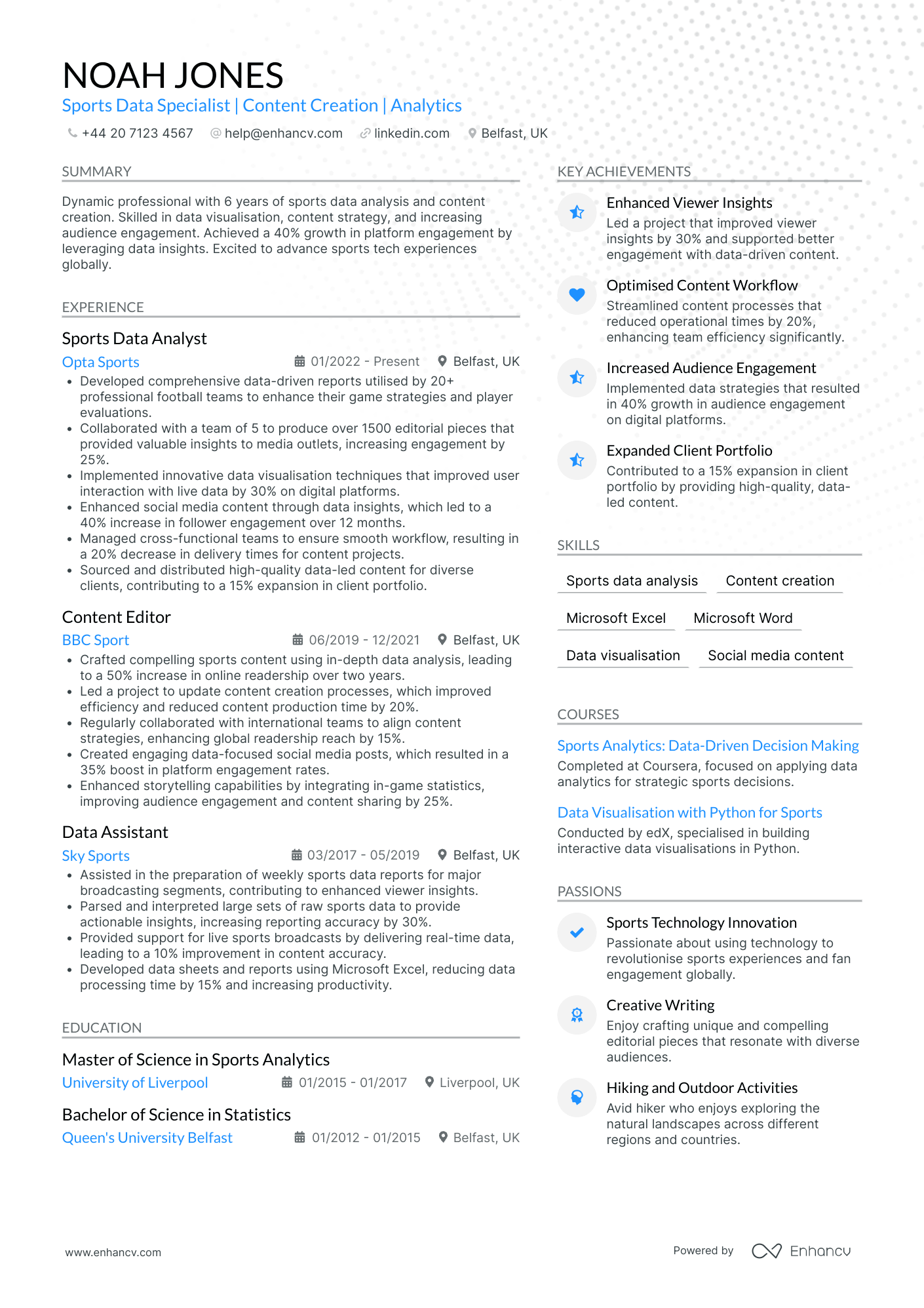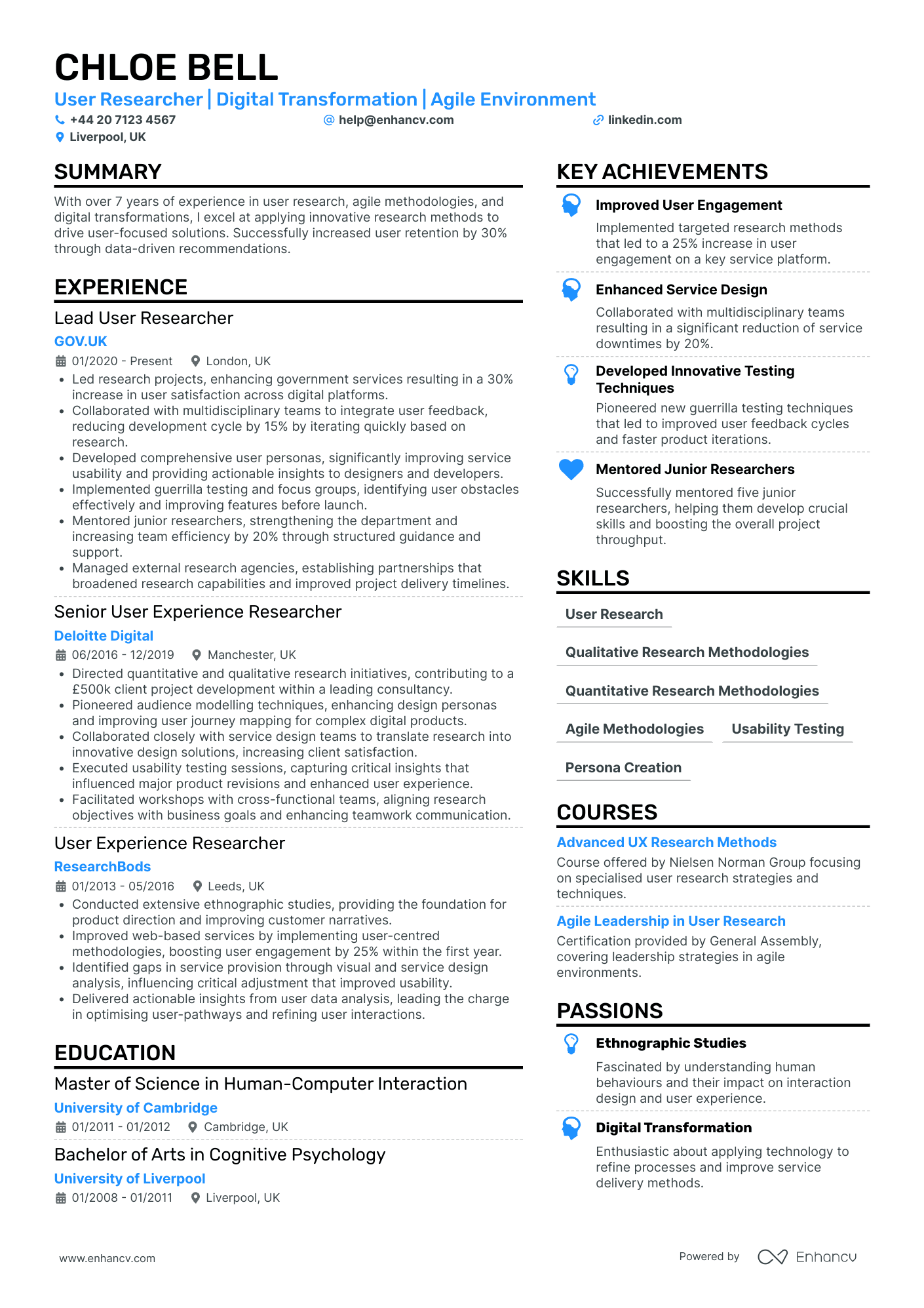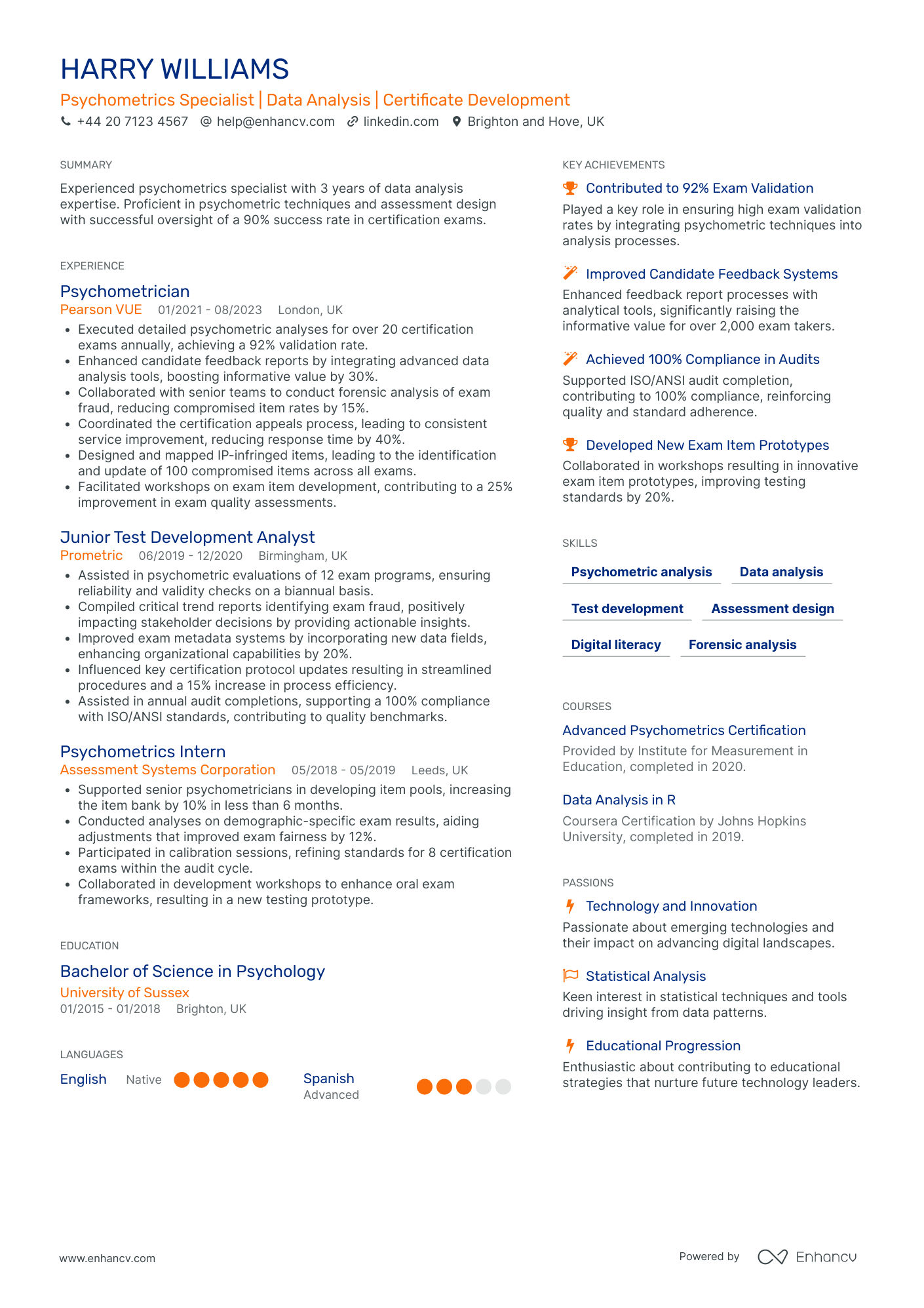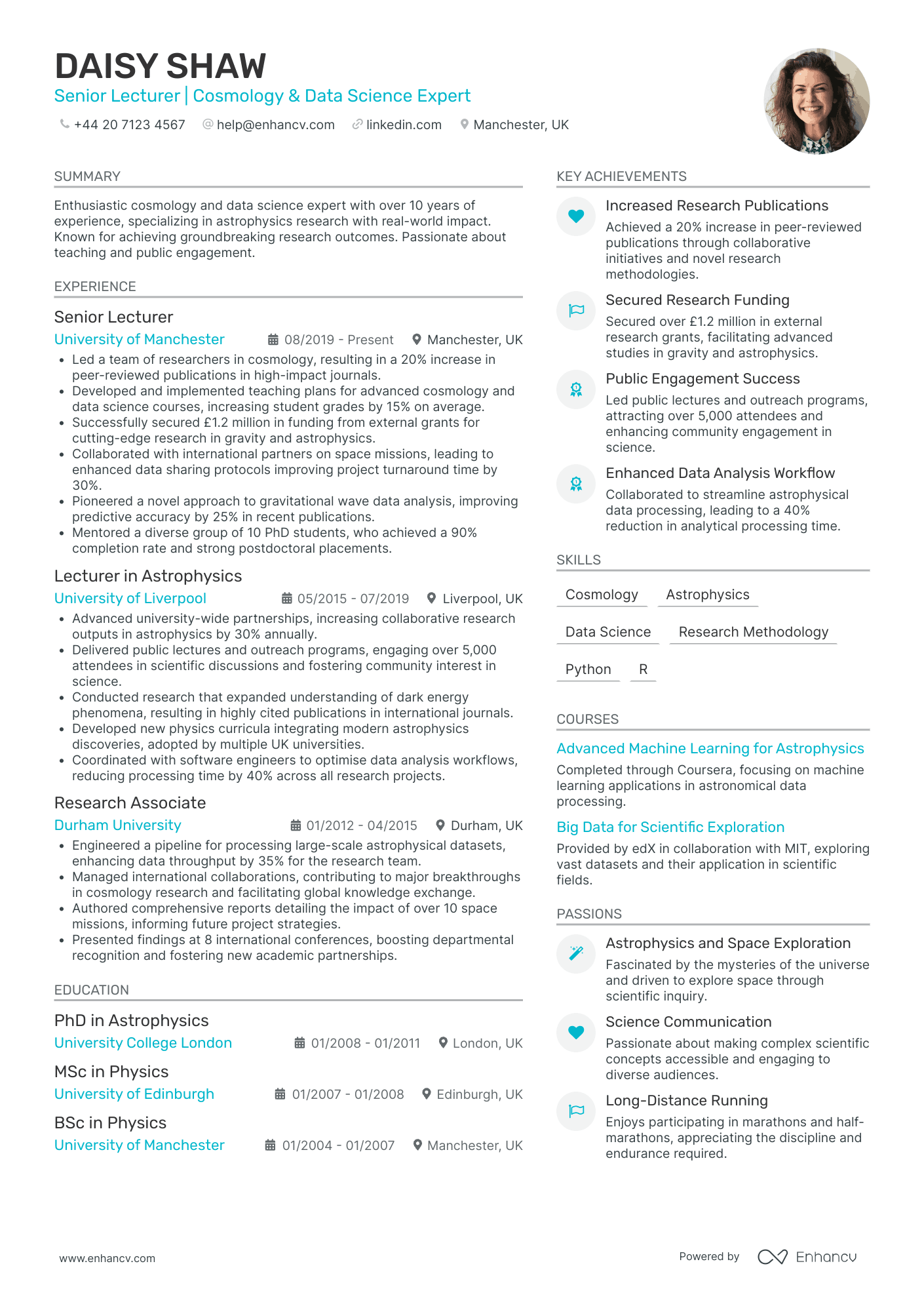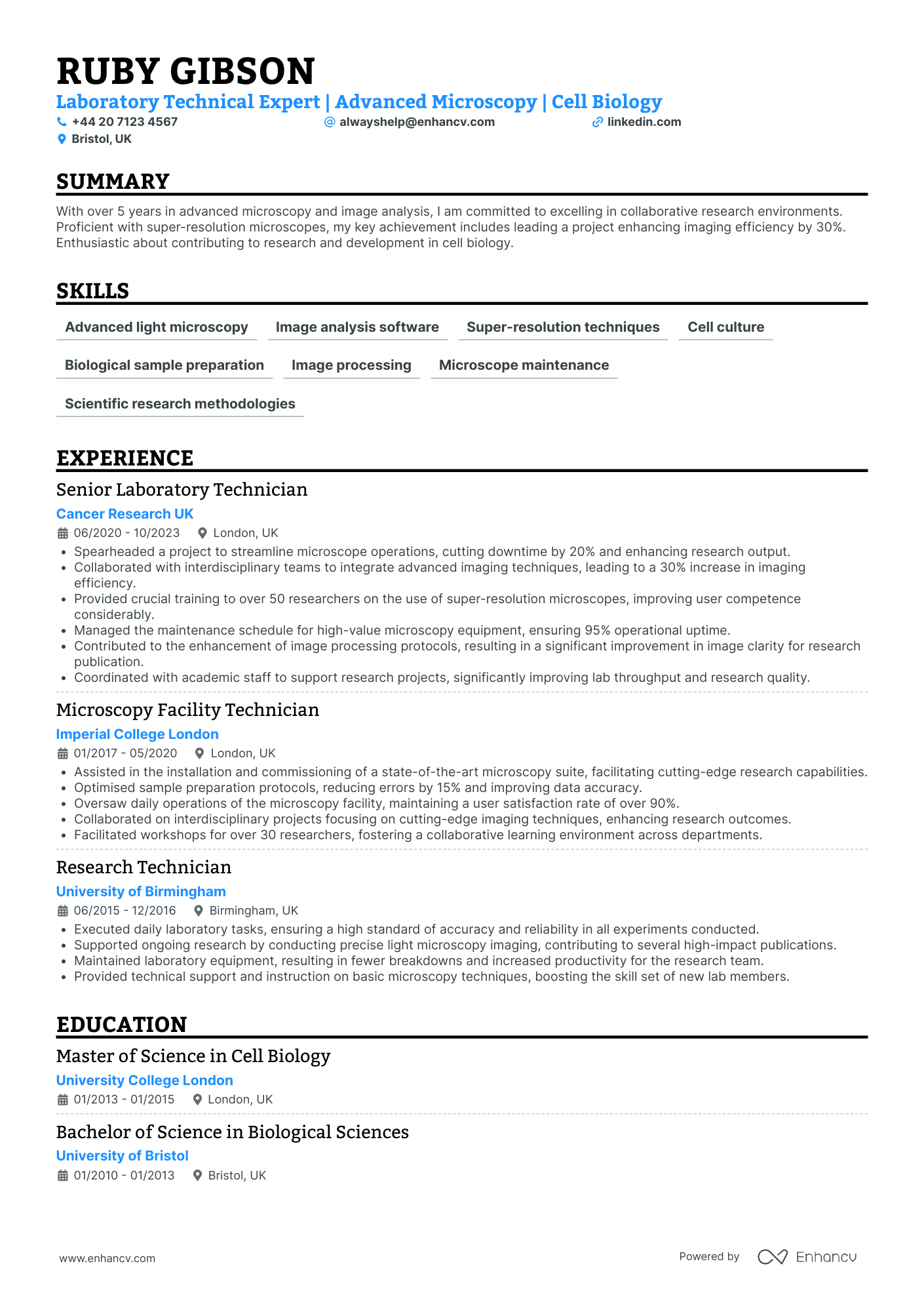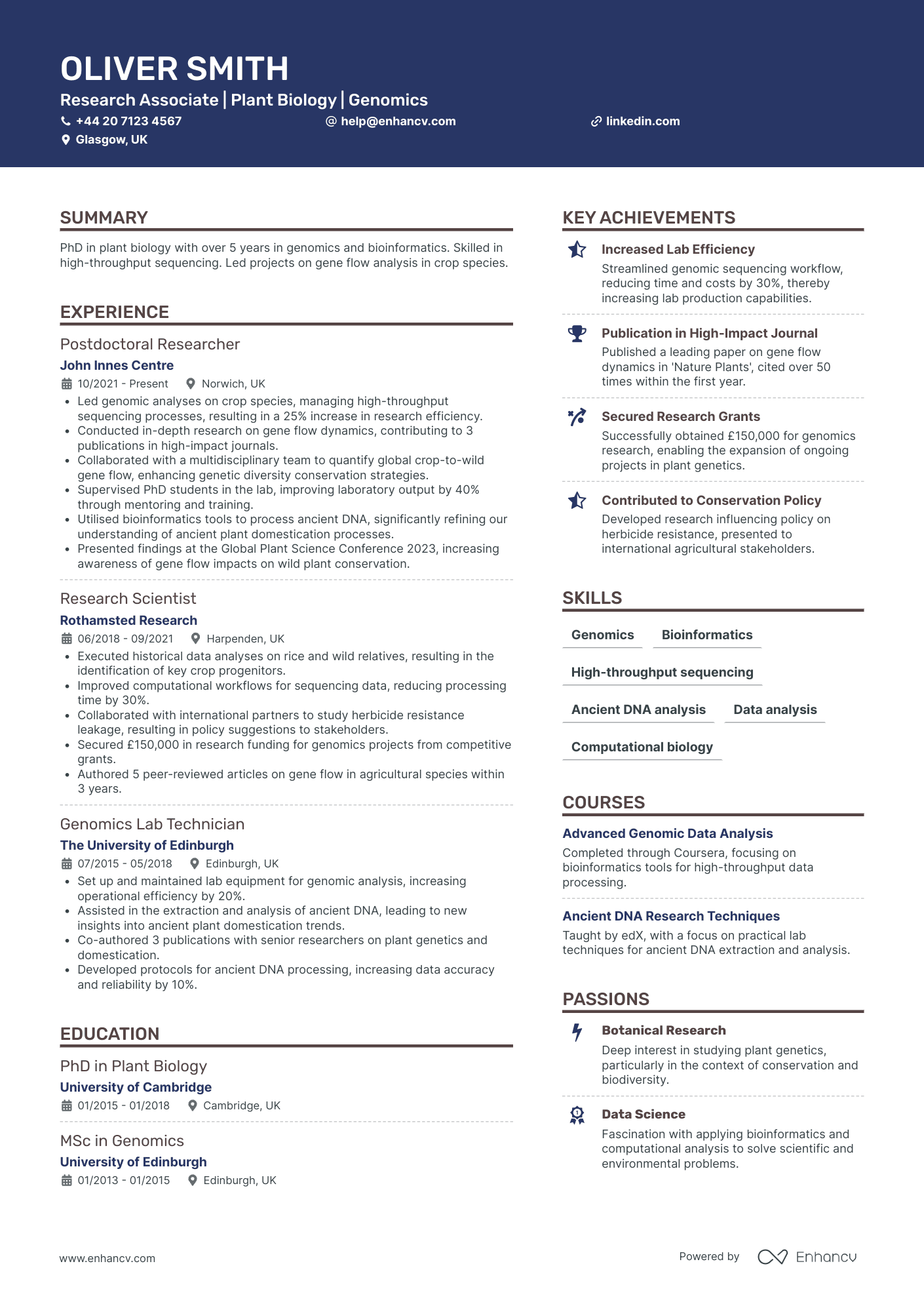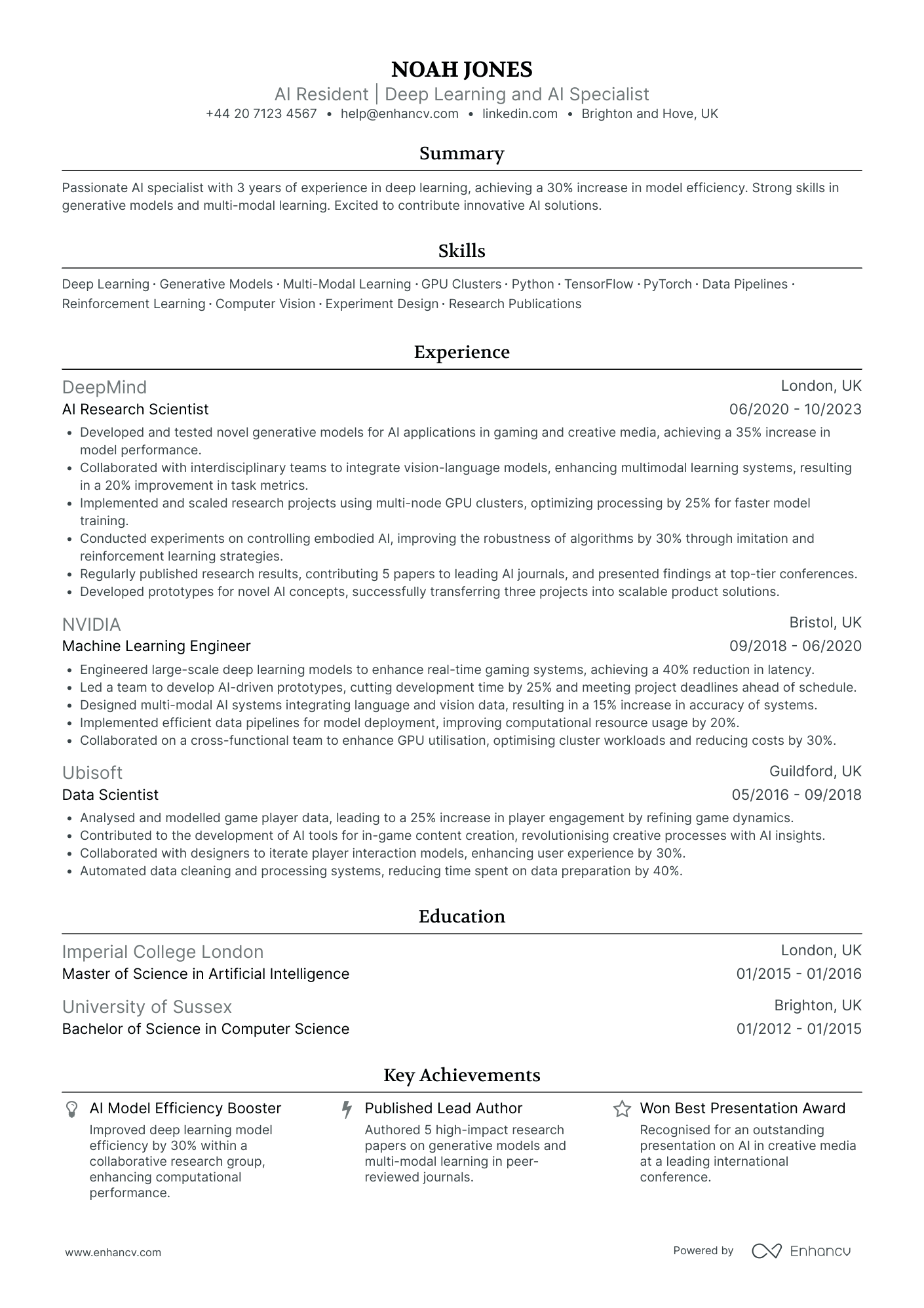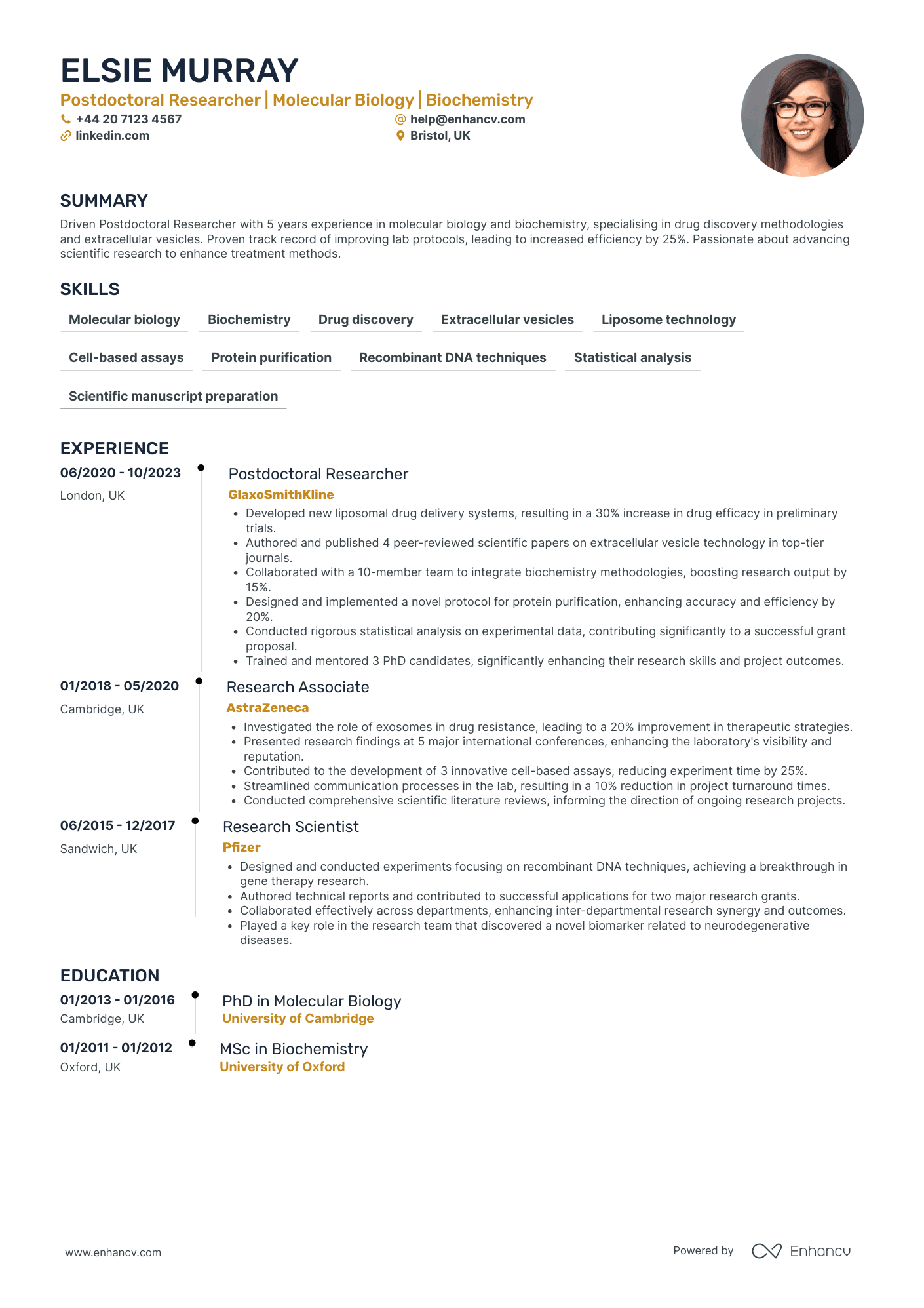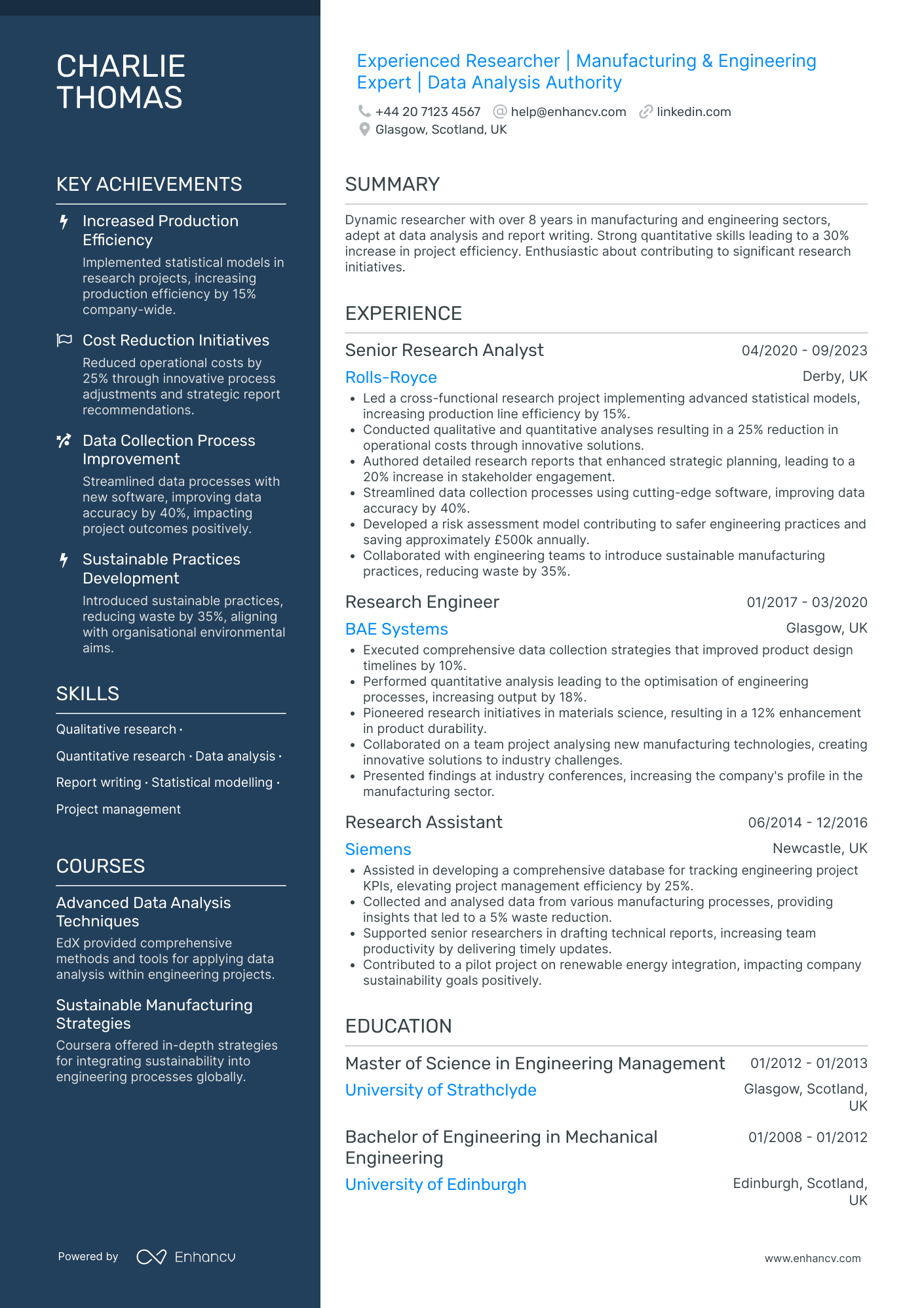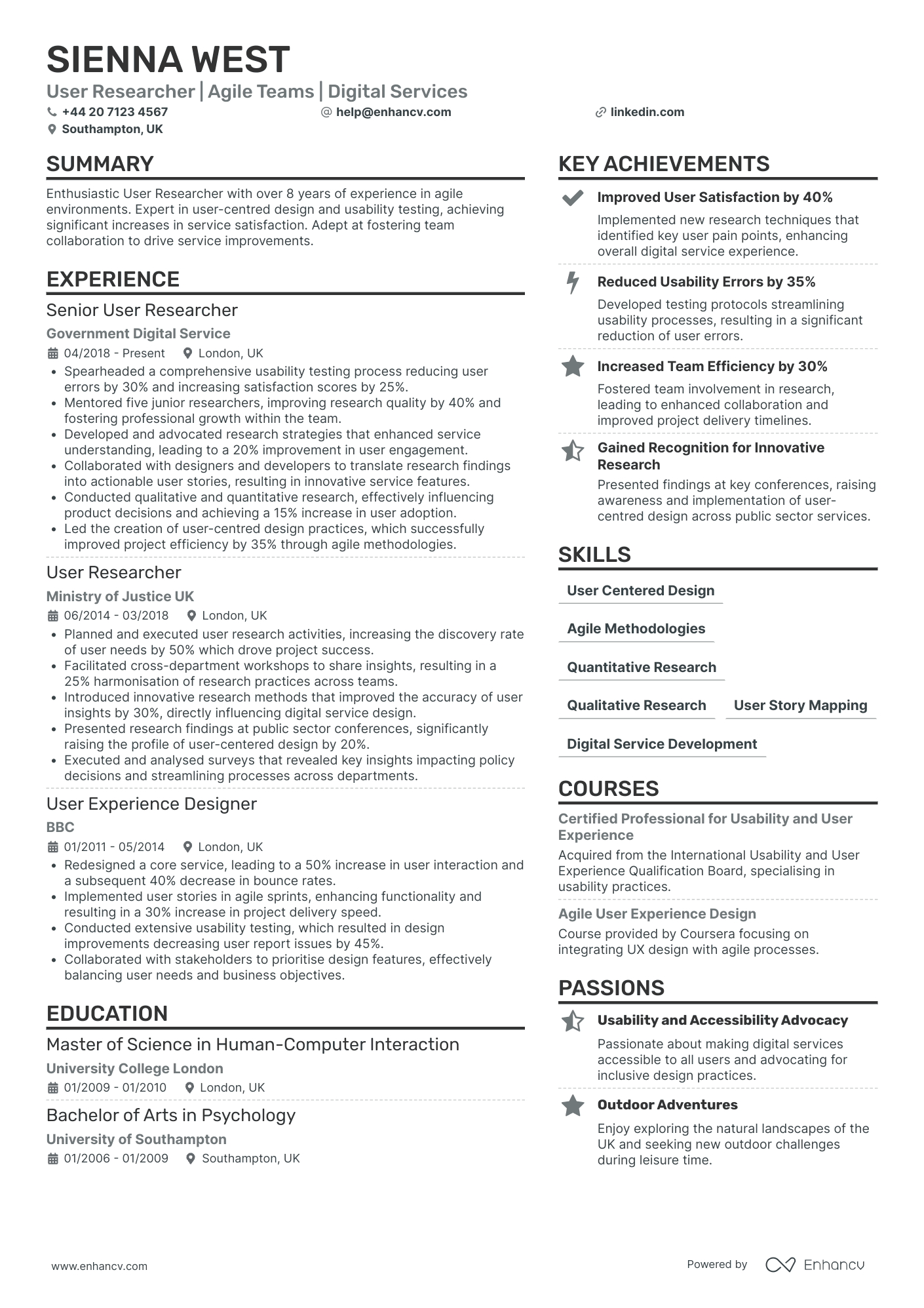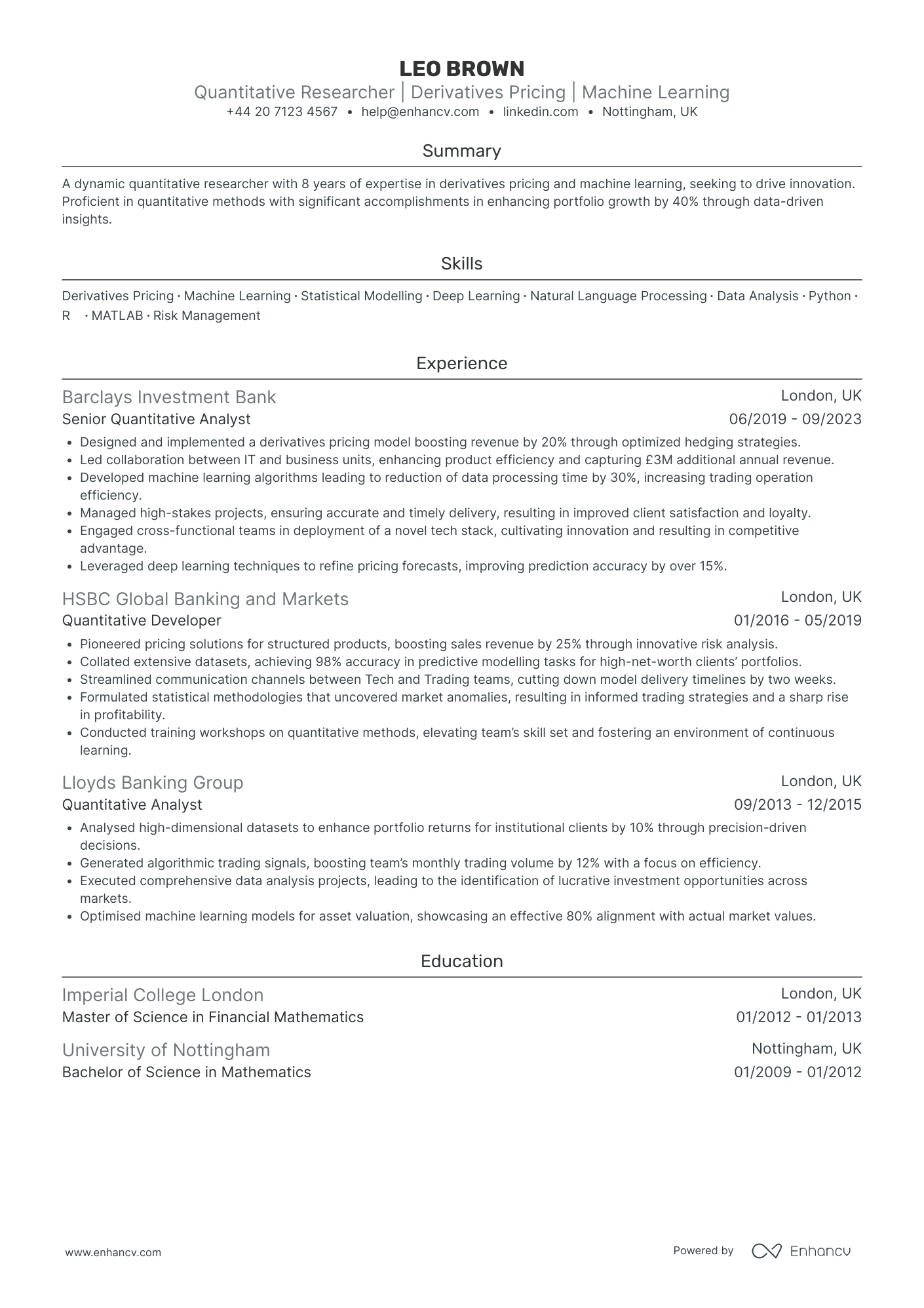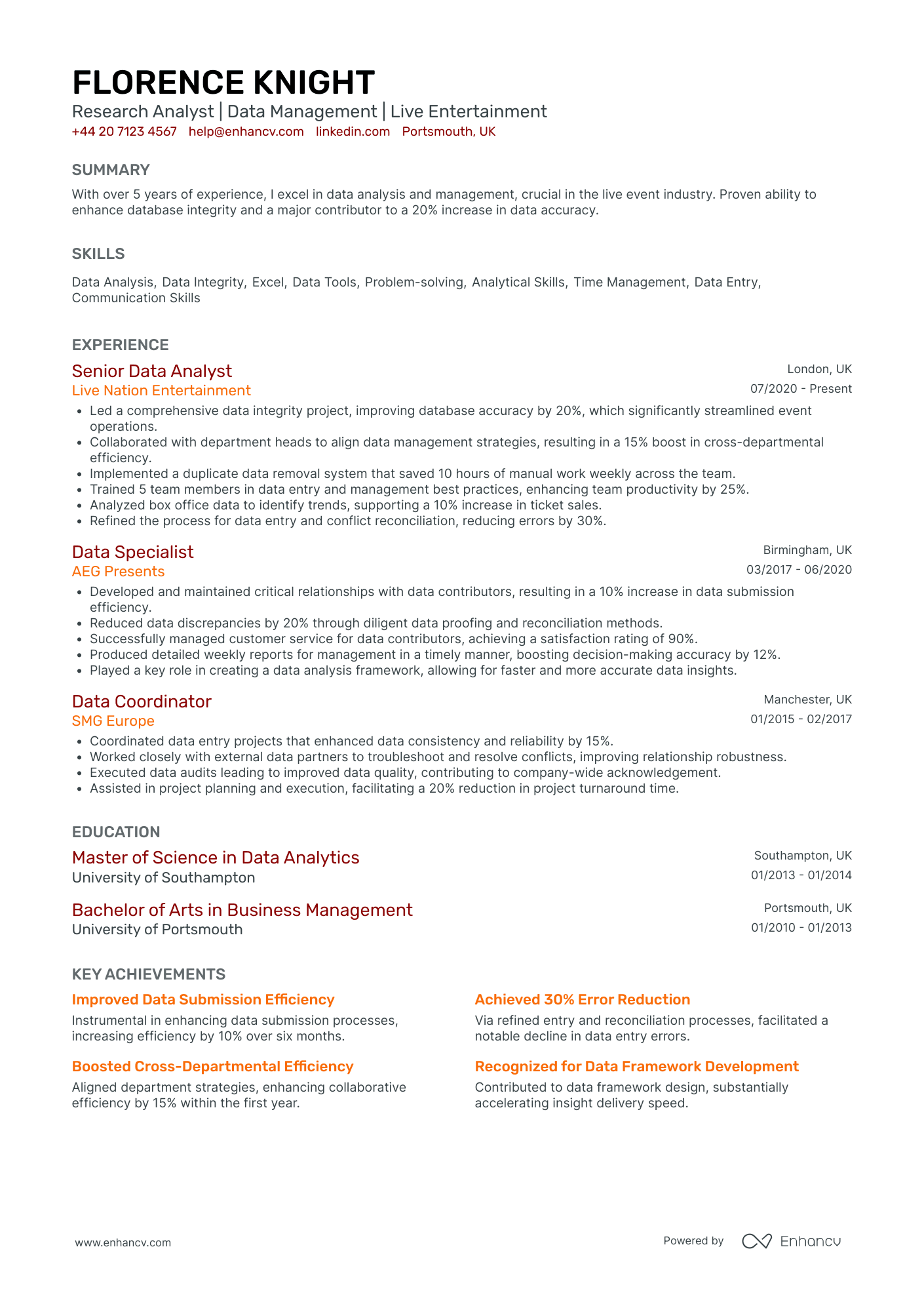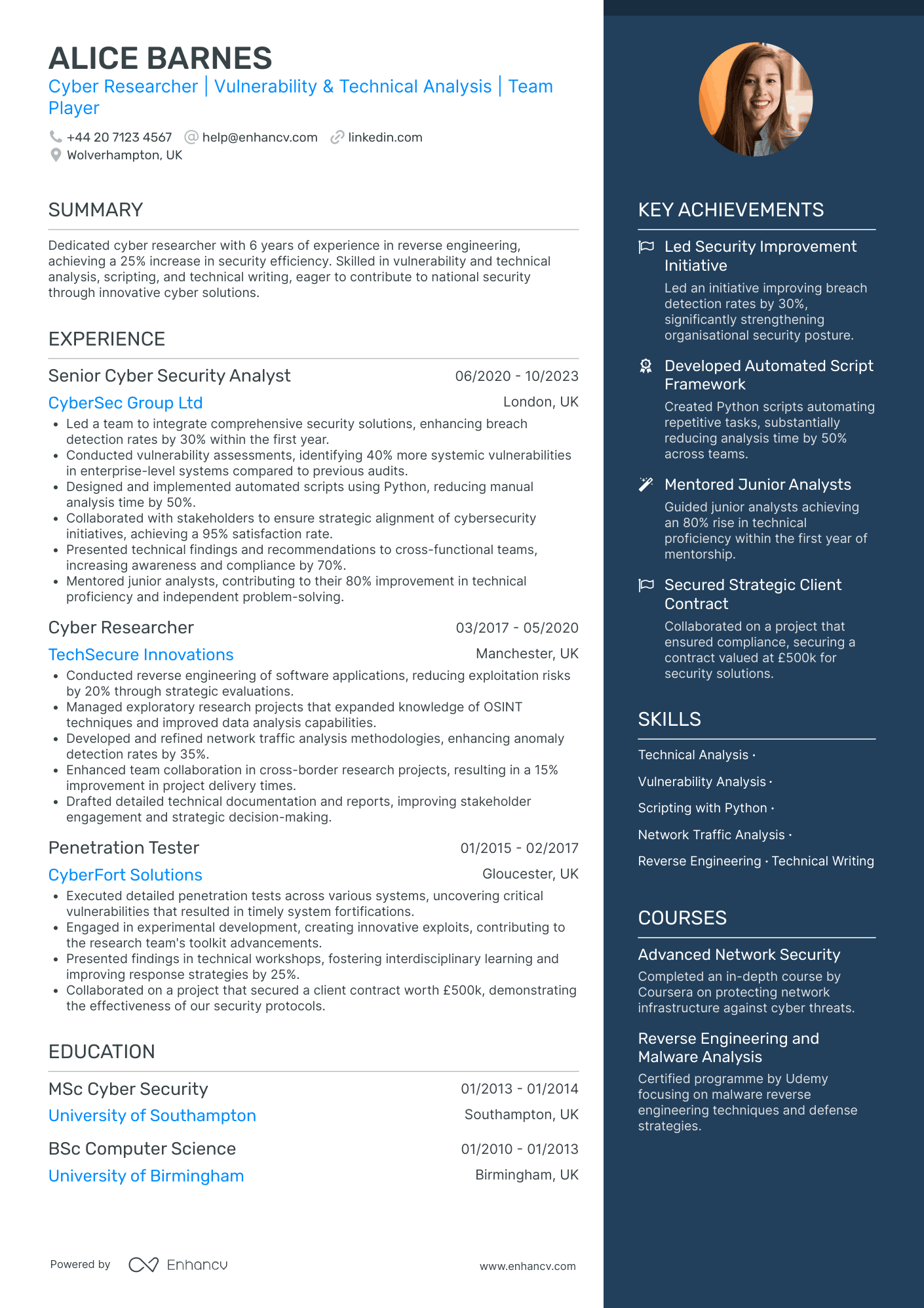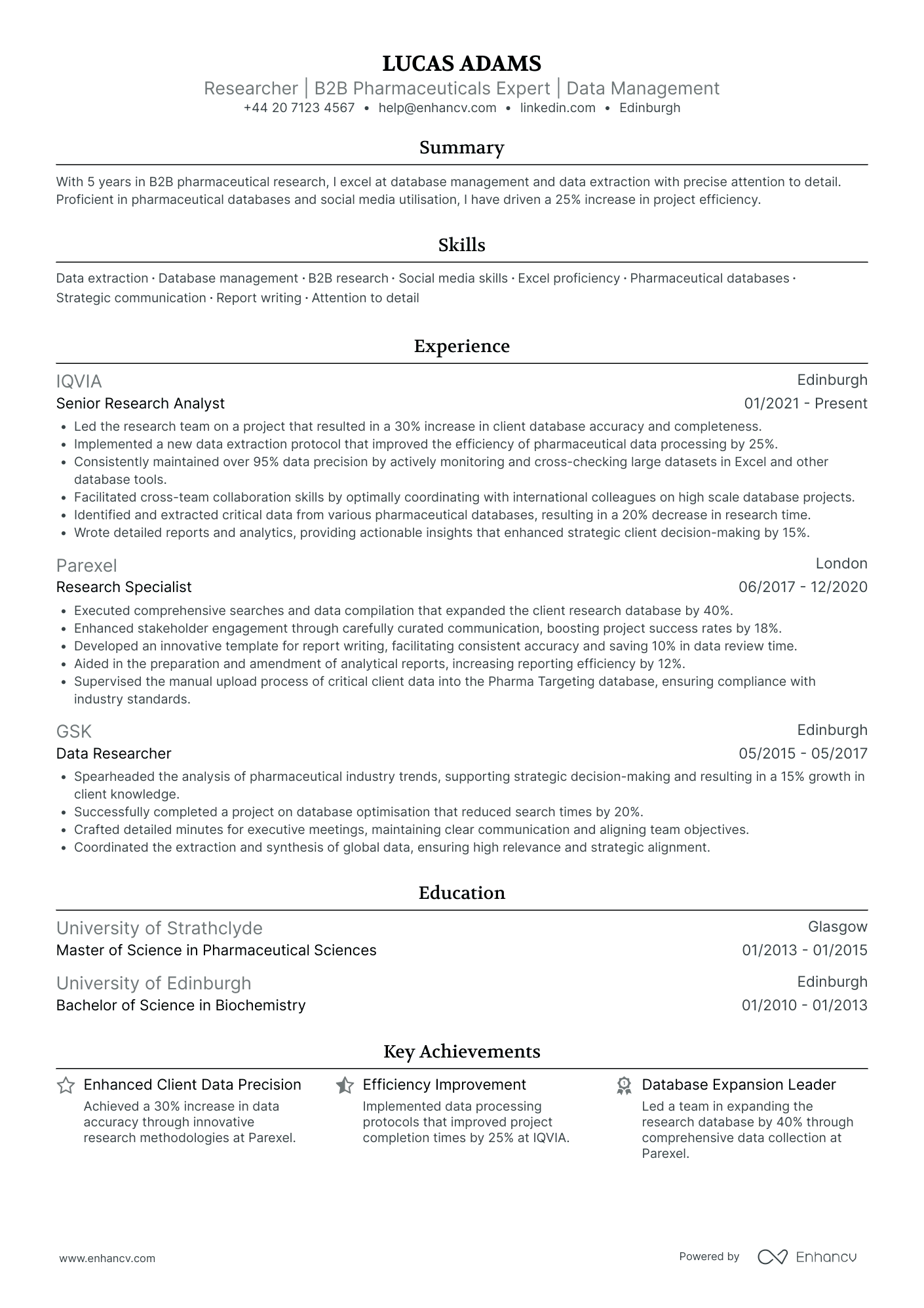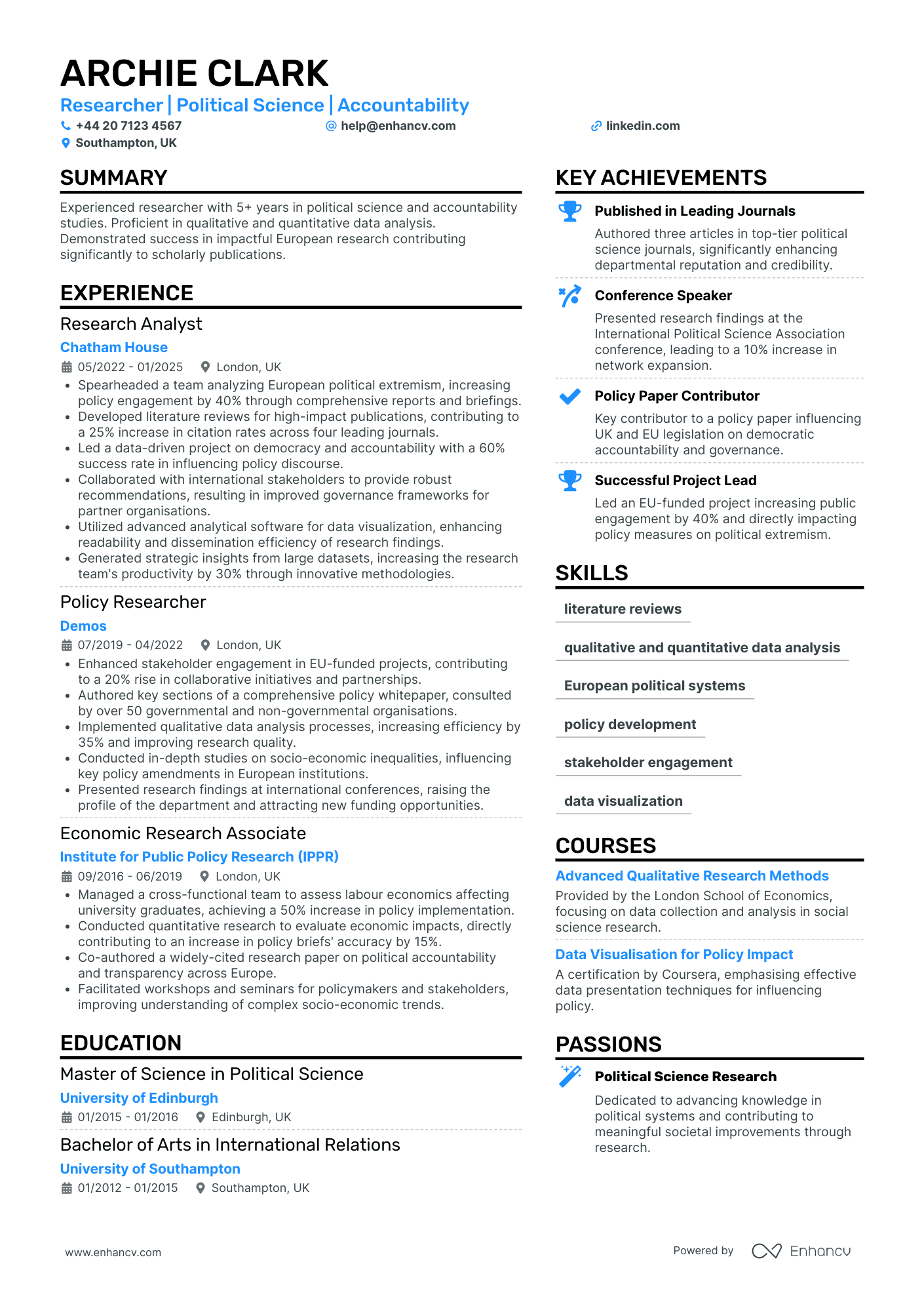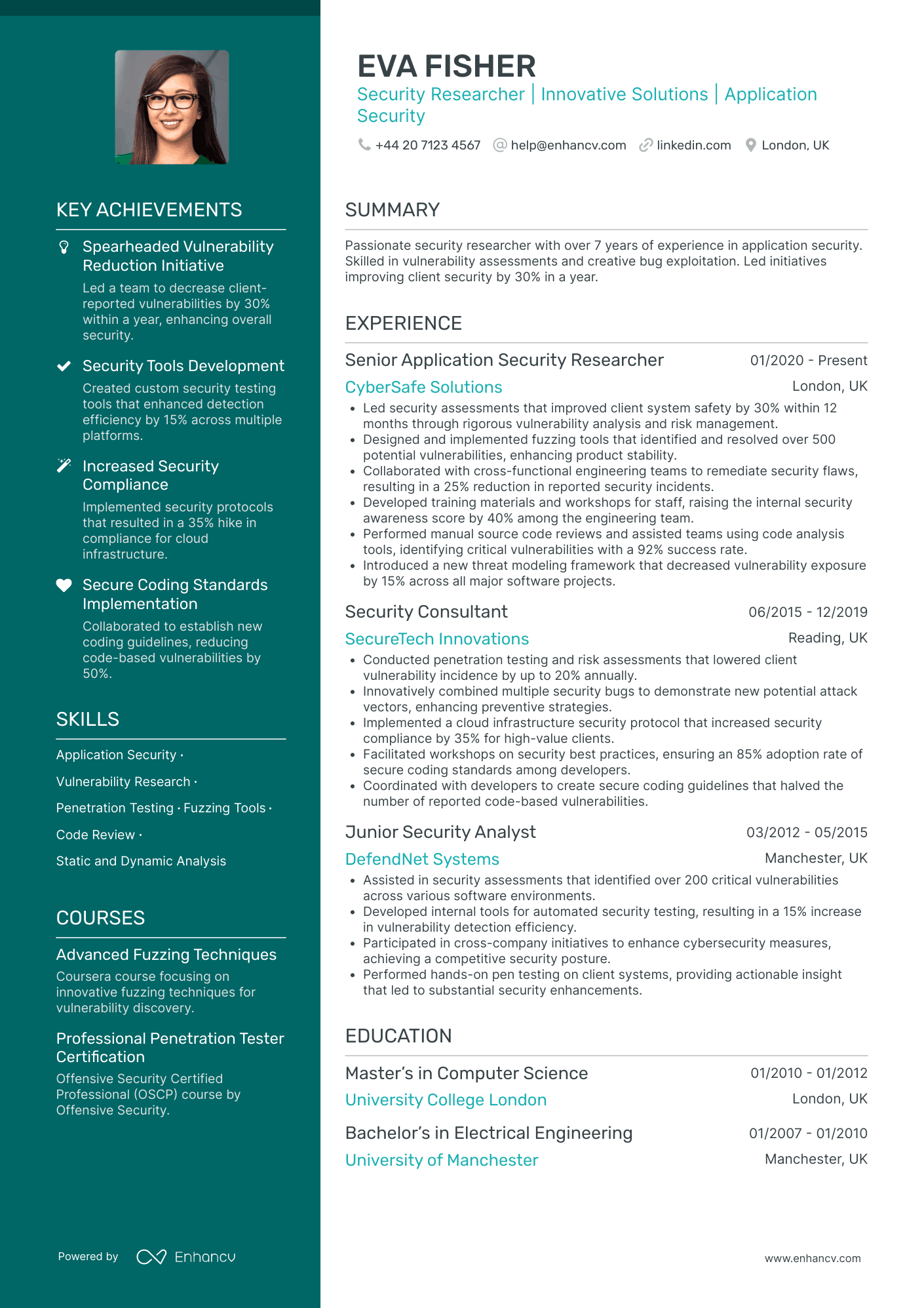Finding adequate, unbiased datasets can be a daunting CV challenge due to the complexity and diversity of visual data required for accurate model training. Our comprehensive guide provides strategies to help you curate and augment datasets, ensuring your computer vision projects are both robust and ethically sound.
- Create an attention-grabbing header that integrates keywords and includes all vital information;
- Add strong action verbs and skills in your experience section, and get inspired by real-world professionals;
- List your education and relevant certification to fill in the gaps in your career history;
- Integrate both hard and soft skills all through your CV.
Discover more industry-specific guides to help you apply for any role in the links below:
CV examples for researcher
By Experience
Senior Clinical Researcher
- Comprehensive Career Progression - Thomas Walker's CV showcases a clear trajectory of growth within the clinical research field, moving from Clinical Research Associate roles to a Senior position, demonstrating increasing responsibility and advancement over time.
- Strong Leadership and Mentorship Skills - The document highlights his contributions beyond his role, with initiatives like developing mentorship programs for junior CRAs, indicating his commitment to team development and leadership.
- Impressive Achievements with Business Impact - His achievements section effectively communicates the impact of his work, such as increasing site compliance by 15% and reducing approval times by 20%, which are significant, quantifiable contributions that enhance operational efficiency and demonstrate business value.
Junior Social Science Researcher
- Strong Content Structuring and Conciseness - The CV is well-structured, presenting information clearly through specific sections for experience, education, skills, and achievements. Each job role includes a concise list of responsibilities and accomplishments, making it easy to identify key experiences and contributions at a glance.
- Illustration of Career Progression - Elsie Murray demonstrates a progressive career trajectory, moving from a Junior Data Analyst to a Research Data Analyst, highlighting her growth within the field of health data science. Each new position carries increasing responsibilities and complexity, reflecting her advancement and commitment to the sector.
- Emphasis on Industry-Specific Tools and Techniques - The CV impressively details a wide array of data science skills relevant to public health, including proficiency in Python, R, SQL, and statistical analysis. The practical application of machine learning to enhance research outcomes portrays Elsie’s technical depth and capability in utilizing advanced methodologies to innovate in public health.
Senior Financial Researcher
- Clear and Structured Presentation - The content is presented with exceptional clarity and organization, allowing the reader to easily follow the career progression and achievements. Each section is well-labelled and concise, providing just enough detail to highlight key skills and experiences without overwhelming the reader.
- Progressive Career Trajectory - Ella Bennett's career shows a clear trajectory of growth and responsibility, advancing from a Quantitative Research Associate to a Senior Quantitative Researcher. This progression demonstrates her increasing expertise in quantitative analysis and her ability to take on leadership roles within the industry.
- Advanced Technical Expertise - Ella's proficiency in industry-specific tools and methodologies is apparent through her use of Python and high-frequency trading data analysis. Her technical depth is further shown by her development of market impact models and her focus on model calibration and integration with trading strategies.
Entry-Level Environmental Researcher
- Clear and Structured Presentation - The CV is meticulously organized, presenting information in logical sections that make it easy to navigate. Each section features succinct bullet points that articulate Noah’s achievements, responsibilities, and contributions without overwhelming the reader.
- Demonstrates Significant Career Growth - Noah's career trajectory shows clear advancement from a Data Assistant at Sky Sports to a Sports Data Analyst at Opta Sports. This progression reflects a deepening of expertise in data analytics and increased responsibilities, indicating a strong professional development within the sports industry.
- Emphasis on Cross-functional Experience - Throughout Noah's career, he has exhibited adaptability by efficiently managing cross-functional teams and collaborating internationally. These experiences highlight his ability to work across different functions and cultural contexts, which is crucial for succeeding in dynamic environments.
Lead Researcher in Data Science
- Content Presentation and Clarity - The CV is structured in a clear and concise manner, effectively presenting the candidate's skills, experience, and achievements. The use of bullet points in the experience section enhances readability and allows for quick assimilation of key accomplishments and responsibilities. This clarity of presentation ensures that potential employers can quickly understand the candidate's qualifications and impact.
- Career Trajectory and Growth - Chloe Bell's career path demonstrates significant growth and upward mobility, with logical progressions from User Experience Researcher to Lead User Researcher. This trajectory reflects her increasing responsibility and influence within her roles, especially noted in her current position where she leads projects and mentors junior researchers, showing her capability to handle leadership roles.
- Industry-Specific Methodologies and Tools - The CV highlights Chloe's technical depth by listing specific methodologies like guerrilla testing and persona creation, which are essential in user research. Additionally, her enhancement of service design and execution of usability testing showcase her expertise in employing practical tools that are relevant and specialized to her field.
Junior Researcher in Human Resources
- Clear Structure and Conciseness - The CV is thoughtfully structured, separating different segments such as experience, education, skills, and achievements. This clear presentation allows for quick absorption of information, showcasing Harry Williams' qualifications effectively without overwhelming the reader.
- Detailed Career Progression - The career trajectory demonstrates a consistent growth path from an intern position to becoming a specialist. Harry's upward movement in reputable companies highlights his expanding expertise and adaptability in the psychometrics and data analysis field.
- Industry-Specific Expertise - This CV displays a strong proficiency in psychometric analysis and validation. The mention of specific methodologies, like forensic analysis and certification appeals processes, underscores Harry's technical depth and understanding of industry-specific processes critical for ensuring exam integrity.
Senior Researcher in Astrophysics
- Strategically structured content presentation - The CV is expertly organized, presenting information in a clear and concise manner. It effectively uses sections like experience, education, skills, and achievements to highlight key strengths, making it easy for the reader to follow the career progression and understand the candidate's qualifications and accomplishments.
- Illustrates pronounced career trajectory and growth - Daisy Shaw's professional journey showcases steady growth within academia, moving from a Research Associate to Lecturer, and finally to a Senior Lecturer position. This upward trajectory is marked by her increasing leadership responsibilities, ability to secure significant funding, and dedication to teaching, reinforcing her seasoned expertise in cosmology and data science.
- Showcases advanced industry-specific expertise - The CV highlights Shaw's deep technical proficiency and innovative methodologies in the field of cosmology and data science. Her application of advanced machine learning for astrophysical data processing and the development of novel gravitational wave data analysis techniques underscore her technical depth and commitment to advancing scientific understanding.
Senior Researcher in Nanotechnology
- Structured and Comprehensive Presentation - The CV is well-organized and clearly formatted, allowing for easy navigation through various sections such as experience, education, and skills. Each section is concise yet informative, providing a thorough overview of the candidate's qualifications relevant to the field of advanced microscopy and cell biology.
- Consistent Professional Growth - Ruby Gibson’s career trajectory demonstrates a clear path of growth and specialization in microscopy and cell biology. Starting as a Research Technician and advancing to a Senior Laboratory Technician at prestigious institutions, this progression highlights a focused development of expertise and leadership capabilities in her field.
- Emphasis on Collaboration and Impact - The candidate’s achievements section highlights notable projects that directly contributed to enhancing research capabilities and outcomes, such as increasing imaging efficiency by 30%. This demonstrates not only technical prowess but also an ability to work collaboratively across disciplines to achieve significant improvements and uphold research standards.
Entry-Level Researcher in Genetics
- Career Trajectory and Growth - The CV presents a well-defined career progression, starting from a Genomics Lab Technician to a Postdoctoral Researcher. This showcases significant professional development with each role carrying increased responsibilities, such as mentoring PhD students and securing substantial research funding.
- Technical Depth and Methodologies - Oliver Smith's background is rich with industry-specific techniques and tools. His expertise in bioinformatics, high-throughput sequencing, and ancient DNA analysis highlights a deep technical proficiency relevant to plant biology and genomics research.
- Achievements and Business Impact - The CV highlights notable achievements, such as increasing lab efficiency by 30% and contributing to conservation policy. These accomplishments demonstrate the candidate's ability to not only achieve academic milestones but also positively impact broader conservation strategies and research efficiency.
By Role
Researcher in Artificial Intelligence
- Structured Presentation and Clarity - The CV is meticulously structured, beginning with personal details and followed by a succinct summary that captures the candidate’s essence as an AI specialist. Each section flows logically, allowing readers to quickly identify key areas of expertise and accomplishments without overwhelming detail, highlighting both technical skills and achievements fluidly.
- Dynamic Career Trajectory - Noah Jones exhibits a dynamic career trajectory, moving from a Data Scientist role at Ubisoft to more advanced positions such as an AI Research Scientist at DeepMind. This progression not only shows growth in responsibility and skill but also a strategic alignment with leading companies in AI technology, indicating a robust and forward-moving career path within the AI sector.
- Technical Depth and Innovation in AI - The CV stands out with its emphasis on cutting-edge AI methodologies and tools like generative models, vision-language models, and reinforcement learning. Noah’s proficiency with tools such as TensorFlow and PyTorch and the implementation of complex, multi-node GPU clusters highlight a deep technical acumen essential for innovation and advancement in AI research and applications.
Biomedical Researcher
- Highlights a strategic career trajectory - Elsie Murray's CV demonstrates both vertical growth, from Research Scientist to Postdoctoral Researcher, and a strategic approach in aligning her skills with industry leaders like Pfizer, AstraZeneca, and GlaxoSmithKline. This progression underscores her ability to adapt and excel within varied environments, emphasizing her dedication to advancing her career in the biopharmaceutical field.
- Emphasizes deep industry-specific expertise - The CV stands out by showcasing Murray's proficiency in advanced methodologies such as liposome technology and extracellular vesicle research. Her ability to contribute significantly to drug discovery efforts and mentor PhD candidates highlights a depth of technical knowledge that positions her as an invaluable resource within the molecular biology and biochemistry sectors.
- Showcases impactful achievements with business relevance - By quantifying accomplishments such as increasing drug efficacy by 30% and boosting research output by 15%, the CV makes a compelling case for Murray's impact on projects and teams. Her contributions to successful grant proposals and securing significant funding further reinforce her ability to deliver meaningful value and drive scientific advancement in her field.
Educational Researcher
- Structured Career Progression - Charlie Thomas's career trajectory showcases a clear advancement from a Research Assistant at Siemens to a Senior Research Analyst at Rolls-Royce, indicating significant growth and a strong focus on increasing expertise in manufacturing and engineering.
- Industry-Specific Expertise - The CV highlights several sophisticated tools and methodologies utilized by Charlie, such as advanced statistical models and risk assessment models, showcasing a high level of technical depth and the ability to implement innovative engineering solutions successfully.
- Diverse Cross-Functional Experience - Charlie’s ability to lead and facilitate cross-functional projects, such as collaborating with engineering teams to introduce sustainable manufacturing practices, demonstrates adaptability and a capacity to work effectively across different roles and teams, enhancing overall project success.
User Experience Researcher
- Content presentation is well-organized and concise - The CV is outstanding in its structure, making each section clearly delineated. The use of bullet points, consistent headings, and succinct language ensures that information is easy to assimilate quickly, giving a recruiter immediate insight into the applicant's qualifications.
- Illustrates a strategic career growth path - The career trajectory shown reflects deliberate and strategic growth, with the candidate consistently taking on roles with increased responsibility. Noticeable are the promotions from specialist roles to managerial positions, demonstrating leadership and a deepening expertise in their chosen field.
- Showcases industry-specific competencies - The inclusion of specialized tools and methodologies emphasizes the candidate's technical depth. The CV lists specific software and methodologies relevant to their field, such as SQL, data modeling, and Lean Six Sigma, underscoring their industry-specific expertise and capacity to handle complex tasks.
Quantitative Researcher in Finance
- Comprehensive Career Progression - Leo Brown's career trajectory is impressive, showing a clear path of growth from a Quantitative Analyst at Lloyds Banking Group to a Senior Quantitative Analyst at Barclays. This progression demonstrates his ability to adapt and excel in increasingly complex and responsible roles within the finance industry.
- Robust Technical Acumen with Financial Emphasis - The CV stands out by incorporating industry-specific tools and techniques, such as derivatives pricing models, deep learning, and statistical modeling. These are crucial for roles in quantitative finance, showcasing Leo's refined expertise and technical prowess in applying these methodologies to real-world financial challenges.
- Effective Collaborative and Adaptive Skills - Leo's ability to foster collaboration between IT and business units and his achievements in streamlining communication channels across departments emphasize his adaptability and leadership skills in cross-functional environments. These qualities are vital in bridging gaps between different teams to enhance operational synergy and efficiency.
Historical Researcher
- Clarity and Structured Presentation - The CV is clearly structured, with distinct sections for experience, education, skills, and achievements that allow for easy navigation and comprehension of the candidate's qualifications. The use of concise bullet points ensures that key information is highlighted efficiently without overwhelming the reader.
- Strong Career Growth in Relevant Industry - Florence Knight's career trajectory exemplifies significant growth and advancement within the live entertainment data management sector, progressing from a Data Coordinator to a Senior Data Analyst. Each role reflects increased responsibilities and contributions, underscoring a consistent focus on enhancing data strategies.
- Impactful Achievements with Business Relevance - Florence's accomplishments are not only quantified but also tied directly to business outcomes, such as streamlining operations, boosting ticket sales, and enhancing data accuracy. These achievements highlight her ability to drive meaningful improvements and align with organizational objectives effectively.
Cyber Security Researcher
- Strategic Career Development - Alice Barnes presents a clear and strategic career path that shows progression from a Penetration Tester to a Senior Cyber Security Analyst. Each career move highlights growth in responsibility and scope, aligning with more complex roles and leadership opportunities across different organizations.
- Adaptability Across Roles and Projects - The CV demonstrates Alice’s adaptability and ability to excel across various roles within the cybersecurity field. Her experience spans reverse engineering, penetration testing, and vulnerability analysis, reflecting a broad skill set and ability to engage in cross-functional and international projects effectively.
- Integrated Corporate Contributions - Alice’s achievements go beyond technical capabilities; they directly contribute to business metrics, like enhancing breach detection rates by 30% and securing a high-value client contract. This reflects her ability to integrate security solutions with business objectives, demonstrating a strategic understanding of cybersecurity's role in business operations.
Pharmaceutical Researcher
- Detailed and Structured Presentation - The CV is meticulously organized with clearly defined sections such as experience, education, skills, courses, achievements, languages, and passions. Each section leverages bullet points for clear and concise delivery of information, ensuring that key points are easily accessible and readable.
- Steady Career Progression in Pharmaceuticals - Over an 8-year span, the career trajectory is marked by continuous growth within the pharmaceutical industry, moving from Data Researcher to Research Specialist, and ultimately to Senior Research Analyst. This progression not only highlights dedication to the field but also showcases an increasing level of responsibility and expertise.
- Emphasis on Data and Technical Proficiency - The CV specifically emphasizes the candidate's prowess in data management and extraction, critical for pharmaceutical research. It lists advanced competencies in database management and Excel proficiency, coupled with industry-specific courses like Pharmaceutical Data Analysis, signaling depth in technical knowledge.
Political Researcher
- Structured and Concise Content Presentation - The CV is organized in a logical format that enhances readability, with clear headings and concise bullet points. This allows for quick navigation through the candidate's qualifications, experience, and achievements, making it easier for potential employers to assess their suitability for a role in political research.
- Dynamic Career Trajectory - Archie Clark’s career path demonstrates progressive growth across renowned institutions like Chatham House and the Institute for Public Policy Research. The progression from an Economic Research Associate to a Research Analyst role showcases a deepening expertise in political science and accountability, indicating a trajectory focused on both breadth and depth in the field.
- Utilization of Advanced Analytical Tools and Methodologies - The CV highlights the use of advanced analytical software for data visualization and strategic insight generation. This not only underlines the technical proficiency in handling complex data but also the ability to communicate findings effectively, improving decision-making processes within political research environments.
Researcher in Forensic Science
- Clarity and Structured Content - The CV is highly organized, starting with personal information and a compelling summary that succinctly establishes the candidate's expertise in security research. The experiences are structured chronologically, providing a clear trajectory of professional growth, with bullet points highlighting achievements in a concise manner.
- Career Trajectory and Industry Growth - Eva Fisher's career trajectory showcases significant growth, advancing from a Junior Security Analyst to a Senior Application Security Researcher. This progression not only indicates her development in technical acumen but also her ability to take on greater responsibilities in cybersecurity over time.
- Technical Depth and Tools Mastery - The CV demonstrates significant industry-specific elements, evident in the use of advanced security methodologies such as fuzzing tools and reverse engineering. Her proficiency in multiple programming languages like Go, Java, and Python adds a layer of technical depth that sets her apart in the field of application security.
Structuring your researcher CV layout: four factors to keep in mind
There are plenty of best practices out there for your CV layout and design. At the end of the day, a clear format and concise CV message should be your top priority. Use your CV design to enhance separate sections, bringing them to the forefront of recruiters' attention. At the same time, you can write content that:
- Follows the reverse chronological order in the experience section by first listing your most recent jobs;
- Incorporates your contact information in the header, but do skip out on the CV photo for roles in the UK;
- Is spotlighted in the most important sections of your CV, e.g. the summary or objective, experience, education, etc. to show just how you meet the job requirements;
- Is no longer than two-pages. Often, the one-page format can be optimal for your researcher CV.
Before submitting your CV, you may wonder whether to export it in Doc or PDF. With the PDF format, your information and layout stay intact. This is quite useful when your CV is assessed by the Applicant Tracker System (or the ATS) . The ATS is a software that scans your profile for all relevant information and can easily understand latest study on the ATS , which looks at your CV columns, design, and so much more.

PRO TIP
Use font size and style strategically to create a visual hierarchy, drawing the reader's eye to the most important information first (like your name and most recent job title).

The top sections on a researcher CV
- Education background is essential, showcasing degrees pertinent to research.
- Research experience highlights relevant projects and your role within them.
- Publications list demonstrates contributions to the scientific community.
- Skills section outlines technical and analytical capabilities.
- Conference presentations show communication skills and subject matter engagement.

What recruiters value on your CV:
- Highlight your research achievements by listing publications, presentations, and any notable research projects you've led or contributed to, ensuring that the most impactful items are clearly emphasised.
- Include a detailed skills section that showcases your proficiency with research methodologies, statistical software, lab techniques, or other tools and languages pertinent to your field of research.
- Provide an overview of your research interests and objectives at the beginning of your CV to give potential employers insight into your academic focus and future research direction.
- Document any grants, scholarships, or funding you have successfully secured to demonstrate your ability to attract financial support for research endeavours, along with the amounts, if substantial.
- Mention any experience with peer review, editorial responsibilities or scientific committee memberships to highlight your involvement and recognition within the research community.
Recommended reads:
Making a good first impression with your researcher CV header
Your typical CV header consists of Your typical CV header consists of contact details and a headline. Make sure to list your professional phone number, email address, and a link to your professional portfolio (or, alternatively, your LinkedIn profile). When writing your CV headline , ensure it's:
- tailored to the job you're applying for;
- highlights your unique value as a professional;
- concise, yet matches relevant job ad keywords.
You can, for examples, list your current job title or a particular skill as part of your headline. Now, if you decide on including your photo in your CV header, ensure it's a professional one, rather than one from your graduation or night out. You may happen to have plenty more questions on how to make best the use of your CV headline. We'll help you with some real-world examples, below.

Examples of good CV headlines for researcher:
- "Senior Data Scientist | Machine Learning Expert | PhD in Computer Science | 10+ Years of Experience"
- "Postdoctoral Research Fellow | Immunology and Infectious Diseases Specialist | Published Author | 5 Years of Post-PhD Work"
- "Clinical Research Associate | Oncology Trials Coordinator | GCP Certified | 3 Years of Field Experience"
- "Lead Environmental Scientist | Climate Change Impact Assessor | MSc Environmental Science | 15 Years' Professional Insight"
- "Junior Materials Engineer | Nanotechnology Innovator | MEng in Materials Science | 2 Years Industrial Exposure"
- "Principal Statistician | Biostatistics and Public Health Analyst | PhD Statistics | 20+ Years of Expertise"
What's the difference between a researcher CV summary and objective
Why should it matter to you?
- Your researcher CV summary is a showcasing your career ambitions and your unique value. Use the objective to answer why your potential employers should hire you based on goals and ambitions. The objective is the ideal choice for candidates who happen to have less professional experience, but still meet some of the job requirements.
Before you select which one will be more relevant to your experience, have a look at some industry-leading CV summaries and objectives.

CV summaries for a researcher job:
- Dynamic bioinformatics specialist with over a decade of experience, skilled in next-generation sequencing and big data analytics. Distinguished by a landmark publication in 'Nature Genetics' revolutionising genome-wide association studies and awarded the 2021 Bioinformatics Excellence Prize.
- Seasoned marine biologist transitioning to computational biology, bringing forward 8 years of oceanic ecosystem expertise. Proficient in Python and data modelling, with a strong track record in peer-reviewed publications focussing on coral bleaching recovery mechanisms. Eager to apply marine life data analysis to genomic research.
- Electrical engineer with a 12-year career at blue-chip technology firms pivoting to machine learning research. Expertise in algorithm development complemented by published works on AI applications in smart grids. Recent completion of an MSc in Artificial Intelligence with distinction from the University of Edinburgh.
- An accomplished materials scientist with upwards of 15 years' experience, specialising in polymer nanocomposites. Holder of 10 patents, with significant contributions to advancing lightweight materials for aerospace applications. Recognised with the Innovative Materials Award in 2022.
- Recent physics graduate from University of Manchester, deeply fascinated by quantum computing. Demonstrated keen aptitude through undergraduate research project on quantum algorithms. Eager to translate theoretical knowledge into practical advancements by contributing to a team pioneering in quantum technologies.
- Motivated recent master's degree recipient in computational neuroscience from the University of Cambridge. Committed to understanding neural network modelling and cognitive function enhancement. Aspires to join a research group dedicated to pushing the boundaries of artificial intelligence and human-computer interface development.
How to meet job requirements with your researcher CV experience
We've now reached the essence of your actual CV - your experience section. This is the space where you can list your career roles and on-the-job successes. Many candidates tend to underestimate just how much time and effort they should put into writing this CV section. Your experience shouldn't be a random list of your responsibilities, but instead:
- Match the job description with your skills, values, and accomplishments;
- Start each bullet with a strong action verb, followed up with one key skill and your outcome of applying this skill;
- Spotlight parts of your career history that are relevant to the job you're applying for.
Before we move on, make sure to check out some professional CV experience sections.

Best practices for your CV's work experience section
- Highlight key research projects and include your role, the objectives, the methodology employed, and any significant outcomes or contributions that resulted from the project.
- Detail any publications with citation information, indicating your contribution to each work, such as first author, co-author, or contributor.
- Specify any grants or scholarships you've attained, including details about the funding body, the value of the grant, and the purpose of the funding.
- Include presentations and posters at conferences, the date, location, and the title of the presentation to underscore your active participation in the academic community.
- Explain any teaching or supervisory experience, including course names, levels taught (undergraduate, postgraduate, etc.), and any innovations or improvements you introduced.
- List technical and laboratory skills that are relevant to your field of research, providing examples of techniques you've mastered or equipment you've used.
- Describe any peer review or editorial experience for academic journals or conferences, which highlights your reputation within the research community.
- Include involvement in professional societies or organisations related to your field, showcasing your networking and collaborative efforts.
- Mention soft skills such as project management, teamwork, and communication, giving relevant examples of how these have been applied in a research context.
- Lead interdisciplinary research team in biotechnology, overseeing a budget of $1.5M, resulting in 2 patents and a 30% acceleration in product development.
- Developed novel analytical methods that increased detection sensitivity by 25%, enhancing product quality and safety standards.
- Authored and co-authored 15 peer-reviewed scientific papers that contributed to the company's reputation as a leader in pharmaceutical research.
- Conducted comprehensive market analyses that identified new market opportunities and influenced the strategic planning process.
- Collaborated with cross-functional teams to develop and refine data collection methodologies, improving data accuracy by 20%.
- Presented research findings to stakeholders through detailed reports and presentations that advised on investment strategies.
- Assisted in the design and execution of clinical trials, contributing to a 15% increase in trial efficiency through process improvements.
- Managed data entry and analysis for over 10 studies, ensuring accuracy and compliance with regulatory standards.
- Supported grant writing efforts that secured $500,000 in funding for ongoing research projects.
- Designed and prototyped new materials for solar panels, increasing energy efficiency by 10% over previous models.
- Led a team of junior researchers in a project to reduce manufacturing costs, ultimately saving the company $200,000 annually.
- Maintained active collaboration with industry partners to integrate cutting-edge technologies into the development of sustainable products.
- Spearheaded a research project that discovered a new compound reducing the progression of neurodegenerative diseases in preclinical models.
- Implemented machine learning algorithms to analyze large datasets, reducing analysis time by 40% and identifying key biological markers.
- Facilitated knowledge transfer sessions with project teams to ensure the application of best practices in scientific research.
- Analyzed consumer behavior trends, delivering insights that contributed to a 15% improvement in product targeting.
- Utilized advanced statistical techniques to validate data integrity and provide a reliable foundation for business decisions.
- Played a pivotal role in a team that successfully launched a new analytics software, leading to a 20% increase in departmental efficiency.
- Orchestrated the deployment of environmental monitoring systems across various ecosystems, significantly enhancing data collection accuracy.
- Conducted in-depth data analyses that informed governmental policy on sustainable land use and conservation efforts.
- Authored a comprehensive research report that influenced a major corporate client's decision to invest in green technologies.
- Coordinated multi-center research studies, optimizing the protocols to standardize practices across teams and improve overall data quality.
- Managed a research portfolio of $3 million, ensuring projects adhered to budget constraints and timelines.
- Mentored junior researchers and provided ongoing education in research methodologies, resulting in higher productivity and research output.
What to add in your researcher CV experience section with no professional experience
If you don't have the standard nine-to-five professional experience, yet are still keen on applying for the job, here's what you can do:
- List any internships, part-time roles, volunteer experience, or basically any work you've done that meets the job requirements and is in the same industry;
- Showcase any project you've done in your free time (even if you completed them with family and friends) that will hint at your experience and skill set;
- Replace the standard, CV experience section with a strengths or achievements one. This will help you spotlight your transferrable skills that apply to the role.
Recommended reads:

PRO TIP
Include examples of how you adapted to new tools, environments, or work cultures, showing your flexibility.
Mix and match hard and soft skills across your researcher CV
Your skill set play an equally valid role as your experience to your application. That is because recruiters are looking for both:
- hard skills or your aptitude in applying particular technologies
- soft skills or your ability to work in a team using your personal skills, e.g. leadership, time management, etc.
Are you wondering how you should include both hard and soft skills across your researcher CV? Use the:
- skills section to list between ten and twelve technologies that are part of the job requirement (and that you're capable to use);
- strengths and achievements section to detail how you've used particular hard and soft skills that led to great results for you at work;
- summary or objective to spotlight up to three skills that are crucial for the role and how they've helped you optimise your work processes.
One final note - when writing about the skills you have, make sure to match them exactly as they are written in the job ad. Take this precautionary measure to ensure your CV passes the Applicant Tracker System (ATS) assessment.
Top skills for your researcher CV:
Data Analysis
Research Design
Statistical Software Proficiency
Technical Writing
Literature Review
Laboratory Skills
Qualitative and Quantitative Methods
Data Presentation
Project Management
Subject Matter Expertise
Critical Thinking
Problem Solving
Communication
Attention to Detail
Time Management
Adaptability
Teamwork
Creativity
Persistence
Ethical Judgement

PRO TIP
Order your skills based on the relevance to the role you're applying for, ensuring the most pertinent skills catch the employer's attention first.
CV education and certificates: your academic background as proof of your skill set
A common misconception about your researcher CV education is that you only need it, if you have less professional experience. That is completely false. The CV education section serves to back up your technical (and sometimes personal) capabilities, fill in gaps in your work history, and show you have the initial industry background and know-how. When creating your education section:
- List your degrees in the reverse chronological order, starting with the most recent (and relevant) ones first;
- Include your degree and university names, start and graduation dates. It's optional to also denote you received a "First-Class Honours" for diplomas that are more relevant to the role;
- Curate your relevant university coursework, projects, or thesis work if you happen to have less professional expertise and need to integrate more job keywords and skills.
Your professional qualifications don't need to stop at your academic background. It's advisable to also select up to three of your most noteworthy (and relevant) industry certificates and feature them in a dedicated section. Once more, include the certificate name, the institution that issued it out, and the date you obtained it on. You could feature both hard skills and soft skills certificates, as in the examples below:

PRO TIP
If you have received professional endorsements or recommendations for certain skills, especially on platforms like LinkedIn, mention these to add credibility.
Recommended reads:
Key takeaways
What matters most in your researcher CV-writing process is for you to create a personalised application. One that matches the role and also showcases your unique qualities and talents.
- Use the format to supplement the actual content, to stand out, and to ensure your CV experience is easy to comprehend and follows a logic;
- Invest time in building a succinct CV top one third. One that includes a header (with your contact details and headline), a summary or an objective statement (select the one that best fits your experience), and - potentially - a dedicated skills section or achievements (to fit both hard skills and soft skills requirements);
- Prioritise your most relevant (and senior) experience closer to the top of your CV. Always ensure you're following the "power verb, skill, and achievement" format for your bullets;
- Integrate both your technical and communication background across different sections of your CV to meet the job requirements;
- List your relevant education and certificates to fill in gaps in your CV history and prove to recrutiers you have relevant technical know-how.
